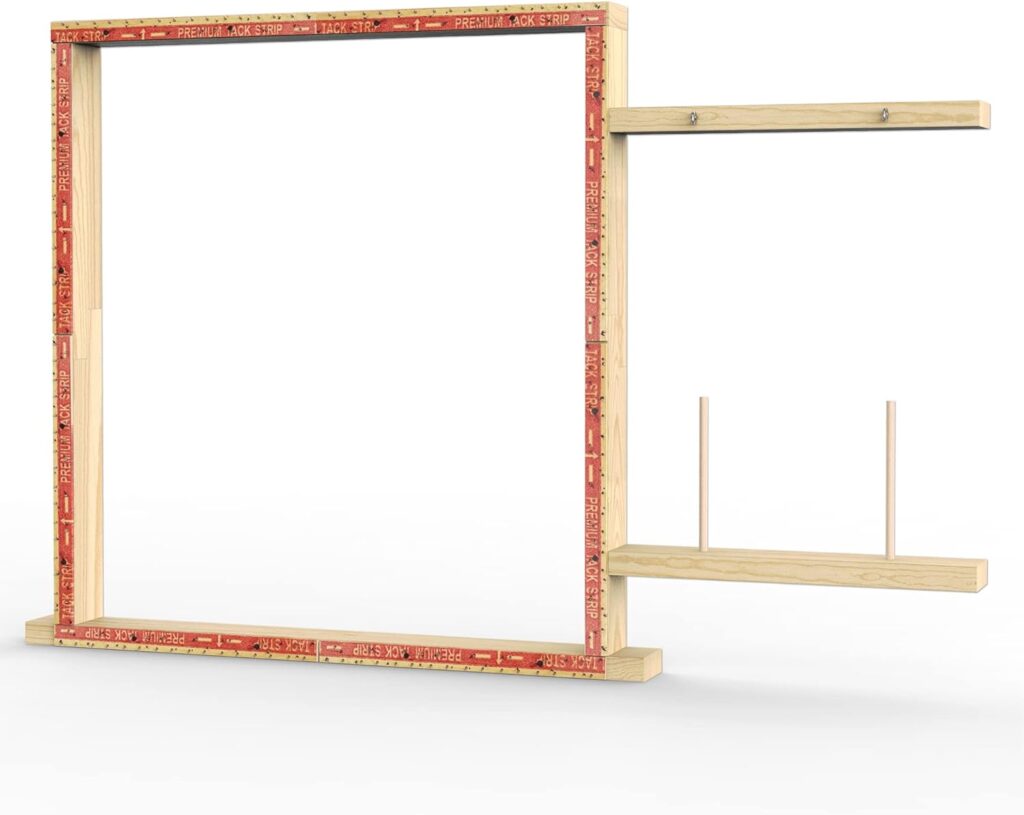Structure Your Style: Elevate Your Projects with Tufting Frames
Tufting frames have become an indispensable tool for crafters and artisans alike, revolutionizing the world of textile arts. If you’re new to the world of tufting or simply curious about this intriguing craft, understanding tufting frames is a great place to start. In this article, we will delve into the basics of tufting frames, exploring what they are, the benefits they offer, and the various types and sizes available.

Artufting Tufting Frame

Tufting is a popular textile art that involves creating patterns and designs by punching loops of yarn through a fabric surface. While a tufting gun is the primary tool for creating tufted pieces, a tufting frame is an essential piece of equipment that helps to keep the fabric taut and prevent any wrinkles or bulges that may occur during the tufting process. In this article, we will explore everything you need to know about tufting frames for tufting using your tufting gun.
What are Tufting Frames?
Tufting frames, also known as rug tufting frames or rug tufting guns, are specialized tools designed to facilitate the creation of tufted textiles. They provide a sturdy and stable work surface where you can securely anchor your fabric or canvas, allowing you to easily insert tufting yarn or fibers and create intricate designs. Tufting frames typically consist of a frame structure, a gripper or clamp mechanism to hold the fabric in place, and sometimes adjustable features to accommodate different project sizes.
A rug tufting frame is a tool that holds the fabric taut and flat while you work on a tufted piece using a tufting gun. A good frame will allow you to easily adjust the fabric tension and angle, which is crucial for creating accurate and consistent tufting. The frame consists of two wooden or metal frames that are connected by bolts, allowing you to adjust the distance between them.
The Benefits of Using Tufting Frames in Your Projects
Using tufting frames offers numerous advantages that make the tufting process more efficient, precise, and enjoyable. Firstly, tufting frames provide a tensioned and stable surface, ensuring that your fabric remains taut throughout the tufting process. This stability enables greater control over the tufting stitches and helps prevent the fabric from bunching or distorting.
Additionally, tufting frames promote ergonomics and reduce strain on your hands and wrists. By securely holding the fabric, they allow you to focus solely on manipulating the tufting gun or needle, eliminating the need for excessive hand tension and minimizing the risk of fatigue or discomfort during long crafting sessions.
Moreover, tufting frames enhance the overall accuracy and consistency of your tufted designs. With the fabric held firmly in place, you can achieve precise placement of tufts, ensuring uniformity and symmetry in your patterns. This level of control is especially beneficial when working on intricate or detailed designs.
Exploring the Different Types and Sizes of Tufting Frames Available Tufting frames come in a variety of types and sizes, catering to the diverse needs and preferences of tufting enthusiasts. Handheld tufting frames are compact and portable, allowing for greater mobility and versatility in your tufting projects. They are particularly popular among beginners and those working on smaller-scale designs.
On the other hand, larger tufting frames offer expansive work areas, accommodating larger fabric or canvas sizes. These frames are ideal for ambitious projects, such as rugs or wall hangings, where a more substantial workspace is required. Some tufting frames even come with adjustable features, allowing you to customize the dimensions to suit your specific project requirements.
It’s worth noting that tufting frames can vary in their construction materials, such as wood or metal, and their additional features, like tilting mechanisms or built-in clamps. Exploring the different options available will help you find the perfect tufting frame that aligns with your artistic vision and crafting style.
Types of Tufting Frames
There are several types of tufting frames available on the market, ranging from simple DIY frames to more complex and adjustable commercial models. Here are some of the most popular types:
DIY Tufting Frames
These are the most basic types of frames and are usually made from wood or PVC pipes. They can be easily customized to fit your fabric size and are a great option for beginners on a budget.
Lap Frames
These frames sit on your lap and hold the fabric in place while you work. They are small and portable, making them ideal for small projects or working on-the-go.
Floor Frames
Floor frames are larger and sturdier than lap frames and are designed to sit on the floor while you work. They usually have adjustable legs and can be adjusted to different angles and heights, making them suitable for larger projects.
Commercial Frames
These are more expensive than DIY frames but offer a greater range of adjustability and features. They are typically made from metal and can hold large and heavy fabrics.
Choosing the Right Frame
When choosing a tufting frame, there are several factors to consider, including the size and weight of your fabric, the adjustability of the frame, and your budget. If you are working on a larger project or a heavy fabric, you may need a sturdier frame with more adjustability.
Additionally, some frames may be better suited for certain types of tufting. For example, if you plan on creating larger-scale tufted rugs, a floor frame with adjustable legs may be more suitable than a lap frame. Consider your specific needs and project requirements when selecting a tufting frame.
Using a Tufting Frame
Once you have selected the right tufting frame for your needs, it is important to know how to properly use it. Here are some tips for using a tufting frame:
- Secure the Fabric: Start by securing the fabric to the frame using clips or tacks. Ensure that the fabric is taut and free of wrinkles or bulges.
- Adjust the Tension: Use the bolts or adjusters on the frame to adjust the fabric tension. This will ensure that the fabric remains taut and flat while you work.
- Position the Frame: Position the frame at a comfortable angle and height. If you are using a floor frame, adjust the legs to the appropriate height.
- Start Tufting: Once the fabric is secured and the frame is adjusted, you can begin tufting using your tufting gun. Work in sections, ensuring that the fabric remains taut and flat as you go.
Features of Tufting Frames
Size
Tufting frames come in different sizes to accommodate different project sizes. Table-top and floor frames are usually larger than lap and hoop frames.
Height Adjustment
Most tufting frames come with adjustable legs to adjust the height. This is important to ensure that you are comfortable while working and that the frame is at the right height for your project.
Material
Tufting frames are made of different materials, including wood, metal, and plastic. The material used affects the durability and weight of the frame.
Tension Adjustment
Some tufting frames have tension adjustments to tighten or loosen the fabric or canvas. This is important for achieving the right tension for your project.
Compatibility
Some tufting frames are only compatible with certain types of fabric or canvas. It’s important to choose a frame that is compatible with the material you will be using.
Benefits of Tufting Frames
Improved Accuracy
Using a tufting frame can help improve the accuracy of your tufting stitches. The frame helps to keep the fabric or canvas taut, making it easier to make even and consistent stitches.
Comfortable Working Position
Tufting frames come with adjustable legs, which means you can adjust the height to a comfortable working position. This helps to prevent back pain and other discomforts associated with prolonged sitting or standing.
Faster Progress
Tufting frames can help you make faster progress on your tufting projects. The frames help to keep the fabric or canvas taut, making it easier to make each stitch quickly and accurately.
Improved Quality
Using a tufting frame can help improve the overall quality of your tufting projects. The frame ensures that the fabric or canvas is taut and evenly stretched, which helps to create a uniform and consistent tufting pattern.
Conclusion
Tufting frames are essential tools for anyone interested in tufting. They come in different types and sizes, and each has its own unique features and benefits. When choosing a tufting frame, it’s important to consider the size, height adjustment, material, tension adjustment, and compatibility with the material you will be using. Using a tufting frame can help improve the accuracy, speed, and quality of your tufting projects while also providing a comfortable working position.
